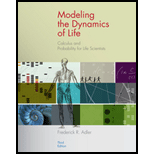
a
To calculate: To find the number of butterflies after migration and after reproduction using the given values
a
Answer to Problem 38E
There are
Explanation of Solution
Given information: Each year, 20% of the butterflies from the first island fly to the second and 30% of the butterflies from the second fly to the first.
Calculation:
Let us consider the following situation. There are two nearby islands which have populations of butterflies, with
Let
Consider the first island. In the beginning there are 100 butterflies out of which 20 migrate to the second island and 30 migrate from the second island to the first island.
Hence, there are
Now consider the second island. In the beginning there are 100 butterflies out of which 30 migrate to the first island and 20 migrate from the first island to the second island.
Hence, there are
Again consider the first island. Now there are 190 butterflies out of which 38 migrate to the second island and 33 migrate from the second island to the first island.
Hence, there are
Now consider the second island- In the beginning there are 110 butterflies out of which 33 migrate to the first island and 38 migrate from the first island to the second island.
Hence, there are
b
To calculate: To find the equations of
b
Answer to Problem 38E
Explanation of Solution
Given information: Each year, 20% of the butterflies from the first island fly to the second and 30% of the butterflies from the second fly to the first.
Calculation:
Now the equation for
Also, the equation for
c
To calculate: To find the discrete-time dynamical system for
c
Answer to Problem 38E
Explanation of Solution
Given information: Each year, 20% of the butterflies from the first island fly to the second and 30% of the butterflies from the second fly to the first.
Calculation:
To find the discrete-time dynamical system for
d
To calculate: To find the equilibrium of
d
Answer to Problem 38E
Using the
This is larger because the butterflies from the first island reproduce.
Explanation of Solution
Given information: Each year, 20% of the butterflies from the first island fly to the second and 30% of the butterflies from the second fly to the first.
Calculation:
To find the equilibrium
Now using the quadratic formula, we get
This is larger than the result in exercise 36 because the butterflies from the first island reproduce.
e
To calculate: To draw the graph using the obtained values
e
Answer to Problem 38E
Hence the graph is drawn using the obtained values.
Explanation of Solution
Given information: Each year, 20% of the butterflies from the first island fly to the second and 30% of the butterflies from the second fly to the first.
Calculation:
The graph along with the cobweb is shown below

Want to see more full solutions like this?
Chapter 1 Solutions
Modeling the Dynamics of Life: Calculus and Probability for Life Scientists
 Algebra: Structure And Method, Book 1AlgebraISBN:9780395977224Author:Richard G. Brown, Mary P. Dolciani, Robert H. Sorgenfrey, William L. ColePublisher:McDougal Littell
Algebra: Structure And Method, Book 1AlgebraISBN:9780395977224Author:Richard G. Brown, Mary P. Dolciani, Robert H. Sorgenfrey, William L. ColePublisher:McDougal Littell Holt Mcdougal Larson Pre-algebra: Student Edition...AlgebraISBN:9780547587776Author:HOLT MCDOUGALPublisher:HOLT MCDOUGAL
Holt Mcdougal Larson Pre-algebra: Student Edition...AlgebraISBN:9780547587776Author:HOLT MCDOUGALPublisher:HOLT MCDOUGAL

 Elementary AlgebraAlgebraISBN:9780998625713Author:Lynn Marecek, MaryAnne Anthony-SmithPublisher:OpenStax - Rice University
Elementary AlgebraAlgebraISBN:9780998625713Author:Lynn Marecek, MaryAnne Anthony-SmithPublisher:OpenStax - Rice University Trigonometry (MindTap Course List)TrigonometryISBN:9781337278461Author:Ron LarsonPublisher:Cengage Learning
Trigonometry (MindTap Course List)TrigonometryISBN:9781337278461Author:Ron LarsonPublisher:Cengage Learning





